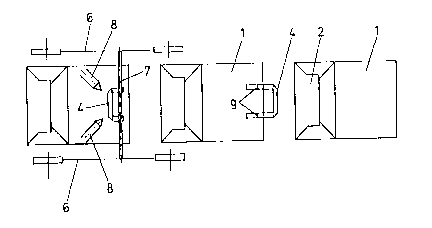Some of the information on this Web page has been provided by external sources. The Government of Canada is not responsible for the accuracy, reliability or currency of the information supplied by external sources. Users wishing to rely upon this information should consult directly with the source of the information. Content provided by external sources is not subject to official languages, privacy and accessibility requirements.
Any discrepancies in the text and image of the Claims and Abstract are due to differing posting times. Text of the Claims and Abstract are posted:
| (12) Patent Application: | (11) CA 2227256 |
|---|---|
| (54) English Title: | PROCESS AND DEVICE FOR PRODUCING BAGS WITH HANDLES |
| (54) French Title: | PROCEDE ET MACHINE POUR LA FABRICATION DE SACS A POIGNEES |
| Status: | Deemed Abandoned and Beyond the Period of Reinstatement - Pending Response to Notice of Disregarded Communication |
| (51) International Patent Classification (IPC): |
|
|---|---|
| (72) Inventors : |
|
| (73) Owners : |
|
| (71) Applicants : |
|
| (74) Agent: | AVENTUM IP LAW LLP |
| (74) Associate agent: | |
| (45) Issued: | |
| (22) Filed Date: | 1998-01-19 |
| (41) Open to Public Inspection: | 1998-07-22 |
| Availability of licence: | N/A |
| Dedicated to the Public: | N/A |
| (25) Language of filing: | English |
| Patent Cooperation Treaty (PCT): | No |
|---|
| (30) Application Priority Data: | ||||||
|---|---|---|---|---|---|---|
|
To produce bags. which are provided with legs, which are cemented to both sides of the opening
sides of the bags and which belong to U-shaped handles made of strip-shaped material, and
whose handle parts are folded over onto the side walls of the bags and fastened with adhesive
spots to the side walls of the bags or the non-folded over segments of the legs, the adhesive
spots are applied. After the legs have been glued to the continuously conveyed bags, the handle
parts are folded over onto the side walls of the bags around prerupture lines of the legs in the
direction of transport.
La présente invention permet de fabriquer des sacs à poignées, lesquelles sont munies de pattes qui se collent sur les deux côtés de l'ouverture des sacs. Les poignées en forme de U, faites de matériau en bande, sont repliées sur les côtés des sacs et collées par points de colle appliqués sur les côtés des sacs ou sur les parties non repliées des pattes. Une fois que les pattes ont été collées sur les sacs en défilement continu, les poignées sont pliées sur les côtés des sacs autour de lignes de prérupture situées sur les pattes, dans la direction de transport des sacs.
Note: Claims are shown in the official language in which they were submitted.
Note: Descriptions are shown in the official language in which they were submitted.

2024-08-01:As part of the Next Generation Patents (NGP) transition, the Canadian Patents Database (CPD) now contains a more detailed Event History, which replicates the Event Log of our new back-office solution.
Please note that "Inactive:" events refers to events no longer in use in our new back-office solution.
For a clearer understanding of the status of the application/patent presented on this page, the site Disclaimer , as well as the definitions for Patent , Event History , Maintenance Fee and Payment History should be consulted.
| Description | Date |
|---|---|
| Inactive: IPC deactivated | 2021-10-09 |
| Inactive: First IPC assigned | 2019-08-21 |
| Inactive: IPC assigned | 2019-08-21 |
| Inactive: IPC assigned | 2019-08-21 |
| Inactive: Adhoc Request Documented | 2018-06-06 |
| Revocation of Agent Requirements Determined Compliant | 2018-05-18 |
| Appointment of Agent Requirements Determined Compliant | 2018-05-18 |
| Inactive: IPC expired | 2017-01-01 |
| Inactive: IPC deactivated | 2011-07-29 |
| Inactive: First IPC derived | 2006-03-12 |
| Inactive: IPC from MCD | 2006-03-12 |
| Time Limit for Reversal Expired | 2003-01-20 |
| Application Not Reinstated by Deadline | 2003-01-20 |
| Deemed Abandoned - Failure to Respond to Maintenance Fee Notice | 2002-01-21 |
| Application Published (Open to Public Inspection) | 1998-07-22 |
| Inactive: IPC assigned | 1998-05-18 |
| Classification Modified | 1998-05-18 |
| Classification Modified | 1998-05-18 |
| Inactive: First IPC assigned | 1998-05-18 |
| Classification Modified | 1998-05-18 |
| Classification Modified | 1998-05-18 |
| Inactive: Single transfer | 1998-04-24 |
| Inactive: Courtesy letter - Evidence | 1998-04-21 |
| Inactive: Filing certificate - No RFE (English) | 1998-04-14 |
| Application Received - Regular National | 1998-04-14 |
| Filing Requirements Determined Compliant | 1998-04-14 |
| Abandonment Date | Reason | Reinstatement Date |
|---|---|---|
| 2002-01-21 |
The last payment was received on 2001-01-12
Note : If the full payment has not been received on or before the date indicated, a further fee may be required which may be one of the following
Please refer to the CIPO Patent Fees web page to see all current fee amounts.
| Fee Type | Anniversary Year | Due Date | Paid Date |
|---|---|---|---|
| Application fee - standard | 1998-01-19 | ||
| Registration of a document | 1998-04-24 | ||
| MF (application, 2nd anniv.) - standard | 02 | 2000-01-19 | 1999-12-17 |
| MF (application, 3rd anniv.) - standard | 03 | 2001-01-19 | 2001-01-12 |
Note: Records showing the ownership history in alphabetical order.
| Current Owners on Record |
|---|
| WINMOLLER & HOLSCHER |
| Past Owners on Record |
|---|
| FRITZ ACHELPOHL |
| WILFRIED LOTZ |